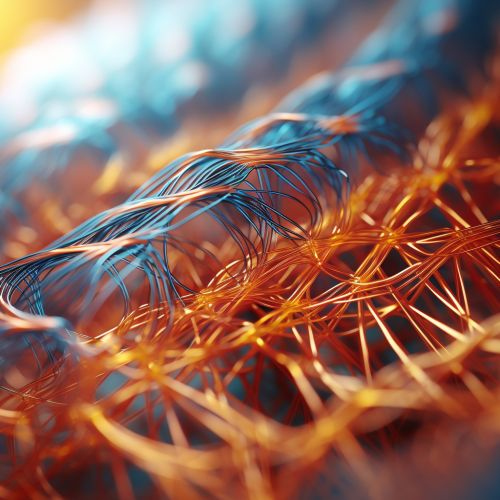Nanofibers
Introduction
Nanofibers are fibers with diameters in the nanometer range. They can be generated from a variety of materials including polymers, metals, and ceramics. The properties of nanofibers have caused researchers and companies to consider using this material in several fields.
Production
Nanofibers are produced by a process known as electrospinning. This process uses an electric field to draw charged threads of polymer solutions or polymer melts up to fiber diameters in the order of some hundred nanometers. Electrospinning from the melt is particularly attractive industrially because it eliminates the need for solvent removal and potentially hazardous solvents.


Properties
Nanofibers have unique properties that make them useful in a variety of applications. These properties include a large surface area to volume ratio, flexibility in surface functionalities, and superior mechanical performance such as stiffness and resilience. The high surface area to volume ratio is particularly beneficial because it can lead to superior performance in applications such as filtration, sensors, drug delivery, and wound healing.
Applications
Nanofibers are used in a number of industrial and commercial applications. These applications include filtration, drug delivery, barrier fabrics, composites, wound dressings, tissue engineering, and protective clothing.
Filtration
Nanofibers are used in air and liquid filtration because they can remove ultrafine particles that are too small for conventional microfiber filters. The high surface area to volume ratio and the small pore size of nanofiber filters make them highly efficient at removing particles from air and liquid streams.
Drug Delivery
Nanofibers can be used for controlled drug delivery because they can be loaded with drugs and then degrade at a controlled rate to release the drugs. The high surface area to volume ratio of nanofibers also allows for high drug loading, which can be beneficial in applications where a high dose of drug is needed.
Tissue Engineering
Nanofibers are used in tissue engineering because they can mimic the extracellular matrix that cells grow on, promoting cell growth and differentiation. The high surface area to volume ratio of nanofibers allows for high cell loading, which can be beneficial in tissue engineering applications where a large number of cells are needed.
Future Developments
Research is being conducted to develop new applications for nanofibers, such as in the areas of energy storage and conversion, environmental protection, and smart textiles. The unique properties of nanofibers, such as their high surface area to volume ratio and flexibility in surface functionalities, make them promising materials for these applications.
